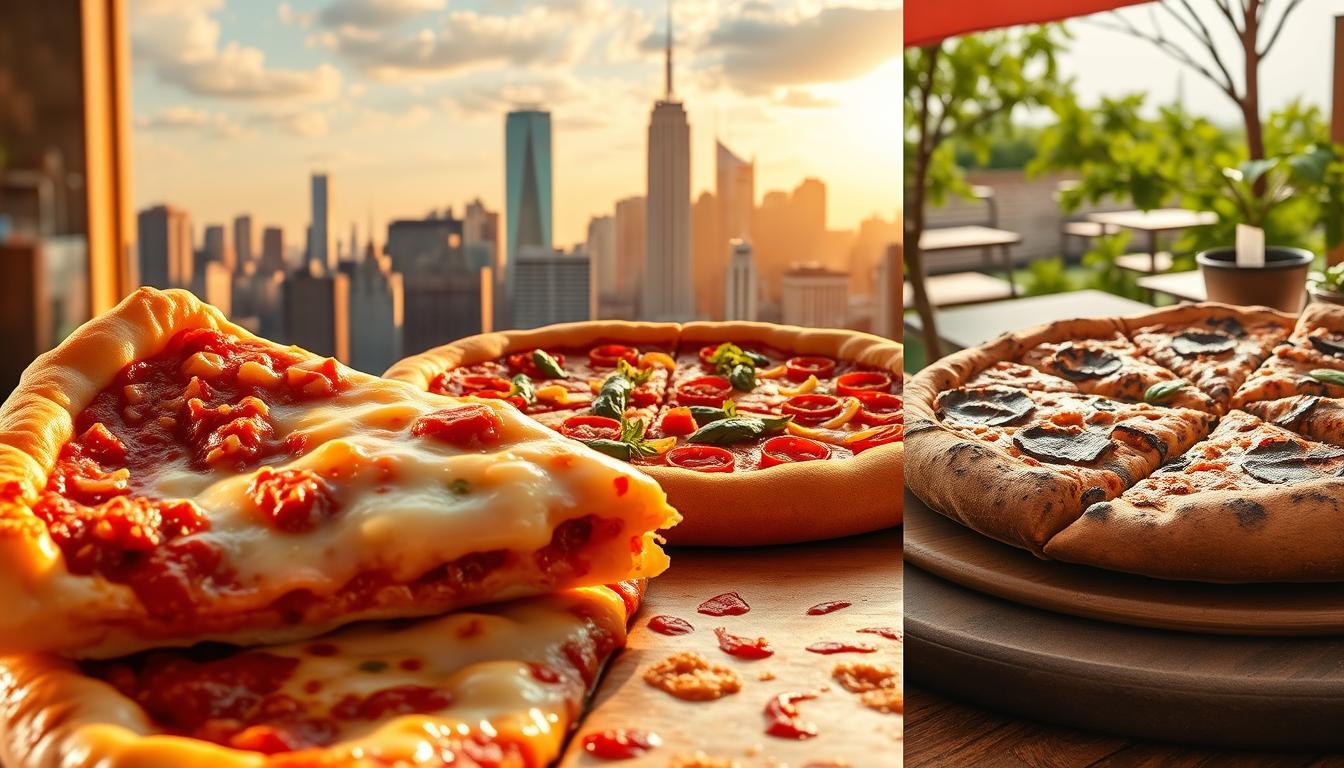Italian immigrants brought pizza to the United States in the late 19th century, and it quickly gained popularity in areas where they settled. The first pizzeria, Lombardi’s, opened in New York City in 1905, marking the beginning of a culinary journey that would transform this beloved dish into various regional styles.
As Italian Americans migrated across the country, they adapted their traditional recipes to local tastes and ingredients, resulting in distinct versions such as New York, Chicago, and California styles. Today, pizza remains a staple in American cuisine, with 13% of the population consuming it on any given day.
For those looking to explore the rich diversity of American pizza culture or simply craving the perfect slice, finding the best pizza near you can be a delightful adventure.
Key Takeaways
- American pizza has evolved significantly since its introduction by Italian immigrants.
- Regional styles reflect local tastes and ingredients, creating a diverse culinary landscape.
- The country’s first pizzeria, Lombardi’s, opened in New York City in 1905.
- 13% of the US population consumes pizza on any given day.
- Distinct regional pizza styles have developed across the United States.
Descoperirea diversității pizzei americane
From its Italian roots to its current status as a beloved American dish, pizza has undergone a remarkable journey in the United States. The post-World War II era was a turning point for pizza in America, as returning soldiers brought back a taste for this Italian bread after being stationed in Italy.
De la tradiția italiană la inovația americană
The rise of pizza chains in the 1960s revolutionized how Americans consumed this dish. Chains like Pizza Hut, Domino’s, and Papa John’s made pizza a convenient and affordable meal for American families, transforming it into a staple of American life.
Cum a evoluat pizza în cultura americană
Television and advertising played crucial roles in cementing pizza‘s place in American culture. The college pizza culture that emerged in the 1970s and 1980s further solidified pizza‘s status as an affordable, communal food. Today, pizza has transcended its Italian origins to become a quintessentially American food, with various regional styles representing different parts of the country.
New York-Style Pizza: Secretele celei mai populare pizza din America
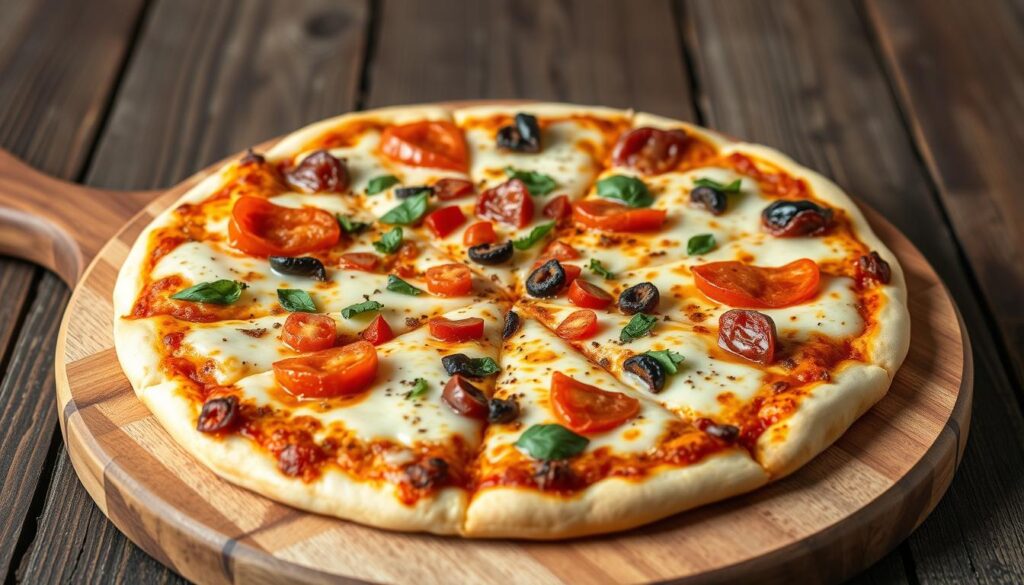
When it comes to iconic American foods, New York-style pizza stands out. This beloved dish is characterized by its thin crust, crispy edges, and foldable slices. The art of making New York-style pizza involves a delicate balance of ingredients and techniques.
Authentic Ingredients for a Thin and Flexible Crust
The foundation of a great New York-style pizza is its crust, made with high-quality flour, water, yeast, salt, and a touch of sugar. For an authentic experience, try using a recipe from mouth-watering pizza recipes to get started.
The Perfect Dough Preparation Technique
Preparing the dough involves mixing the ingredients and allowing the dough to rise, then shaping it into balls and letting them rest before stretching them into thin circles. This process requires patience and practice to achieve the perfect crust.
Traditional Sauce and Toppings
The sauce is made with canned tomatoes, salt, and minimal seasonings. It’s applied sparingly to prevent the crust from becoming soggy. Toppings like pepperoni, sausage, mushrooms, and bell peppers are classic choices, paired with low-moisture mozzarella cheese. The pizza is then baked in a high-heat oven to achieve the signature crust.
Chicago Deep-Dish: Rețeta completă pentru pizza în stil tavă adâncă
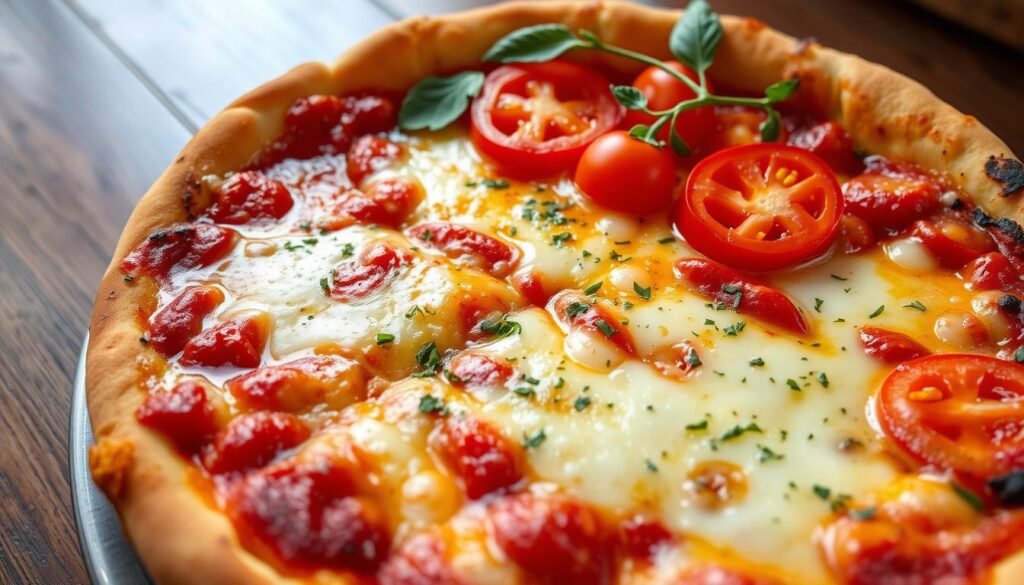
When it comes to hearty, satisfying pizzas, few styles compare to the Chicago deep-dish. This beloved pizza style is known for its thick crust, formed into a deep pan and topped with a thick layer of cheese, meats, and vegetables.
The Secrets of a Perfect Deep-Dish Crust
The crust is the foundation of a great Chicago deep-dish pizza. To achieve the perfect crust, it’s essential to use the right ingredients and techniques. The dough should be made with a mixture of flour, water, and cornmeal to give it a crunchy texture. A well-made crust should be flaky and buttery, with a crunchy edge.
Layering the Ingredients Correctly
Layering is crucial in a Chicago deep-dish pizza. The order is typically reversed from other pizza styles, with the cheese at the bottom, followed by meats and vegetables, and finally the tomato sauce on top. This layering helps to keep the crust crispy and prevents the sauce from making it soggy.
Ideal Baking Time and Temperature
Baking a Chicago deep-dish pizza requires patience and precision. The pizza should be baked in a moderate-temperature oven (around 425°F) for 30-45 minutes. The key is to cook the pizza slowly to ensure the crust is golden brown and the filling is heated through. It’s also important to let the pizza rest for a few minutes before serving to allow the filling to set.
To achieve the perfect Chicago deep-dish pizza, it’s crucial to balance the cooking time and temperature. A properly baked pizza should have a golden-brown crust, a crispy exterior, and a tender interior, with a fully cooked but still moist filling.
Detroit-Style Pizza: Crusta crocantă cu margini caramelizate
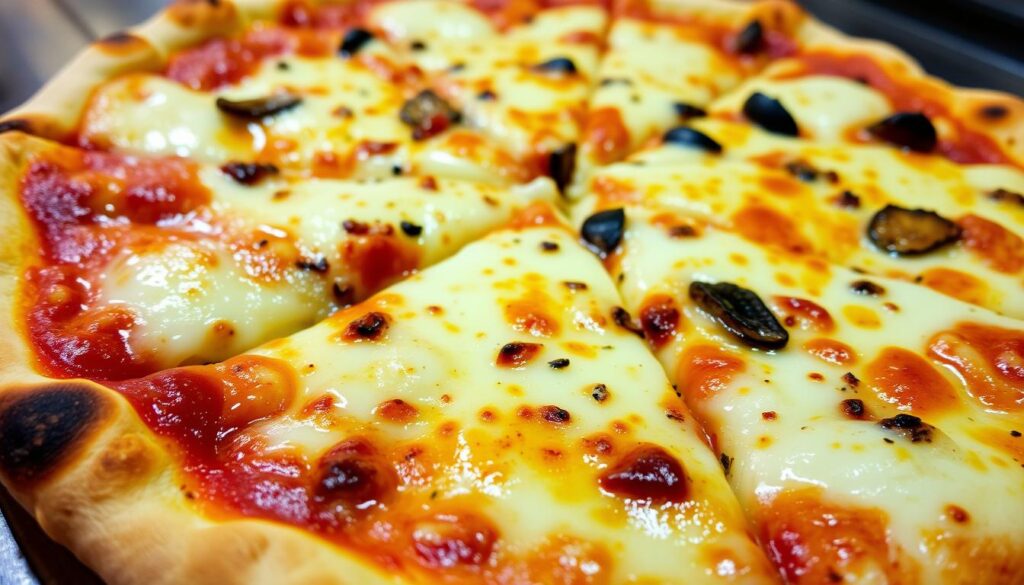
The Motor City’s contribution to the pizza world, Detroit-style pizza, boasts a crunchy crust and a cheesy, caramelized edge. This style of pizza is baked in a square pan and is known for its thick crust and generous cheese.
Alegerea tăvii potrivite pentru pizza Detroit
Choosing the right pan is crucial for achieving the signature Detroit-style pizza crust. A well-seasoned square pan helps in creating the crispy edges.
Tehnica pentru obținerea marginilor caramelizate
To get the perfect caramelized edges, the pizza needs to be baked at a high temperature. The cheese should be spread all the way to the edges to achieve the desired caramelization.
Combinații de brânzeturi recomandate
Traditional Detroit-style pizza uses Wisconsin brick cheese, which has a mild flavor and melts beautifully. If brick cheese isn’t available, a mix of mozzarella and cheddar can be used as a substitute.
California-Style Pizza: Inovație și ingrediente proaspete
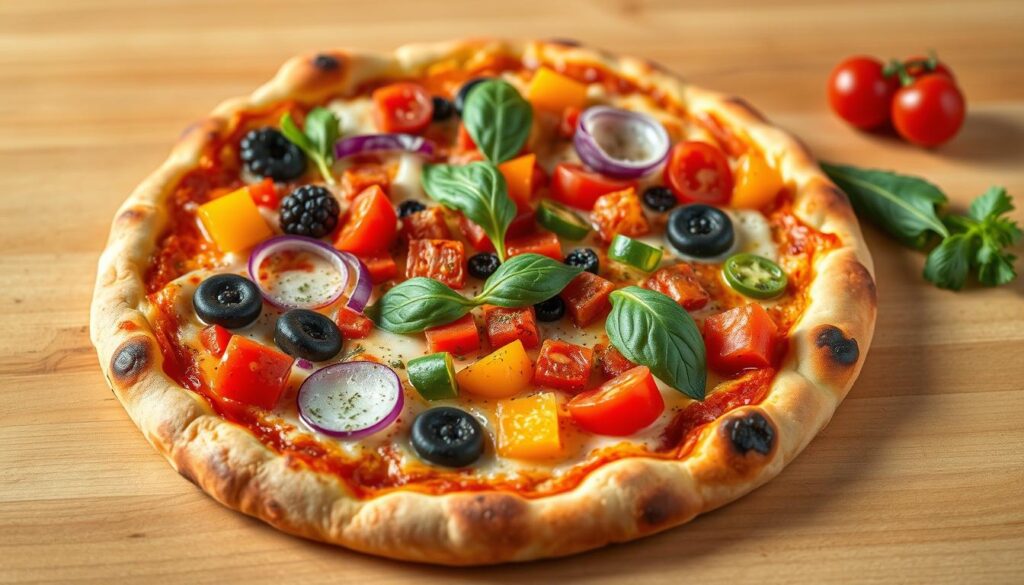
Embracing creativity and experimentation, California-style pizza has evolved into a distinct culinary phenomenon. This style of pizza is characterized by its use of fresh, high-quality ingredients and innovative topping combinations.
The Foundation of California-Style Pizza
The base of a California-style pizza is typically made with a thin crust, cooked to perfection either in a brick oven or on a grill. This method gives the crust a unique flavor and texture. The foundation is crucial as it supports the creative toppings that California-style pizzas are known for.
Unconventional Toppings and Creative Combinations
California-style pizzas often feature non-traditional toppings and combinations that reflect the state’s diverse culinary influences. Examples include pizzas topped with ingredients like pineapple and barbecue chicken or more exotic combinations found in creative pizza recipes. The use of fresh, locally-sourced ingredients is a hallmark of this style, allowing for a wide range of flavors and ingredients to be incorporated into a single dish.
Fusion-Inspired Recipes
California fusion pizzas represent a culinary melting pot, drawing inspiration from various international cuisines. For instance, Asian-fusion pizzas might feature lemongrass chicken and sriracha aioli, while Latin-inspired pizzas could include carnitas and cotija cheese. These innovative combinations result in unique flavor profiles that are characteristic of California-style pizza. The diversity in toppings and combinations not only reflects California’s cultural diversity but also contributes to the popularity of this pizza style among adventurous food enthusiasts.
St. Louis-Style Pizza: Crusta crocantă ca un biscuite
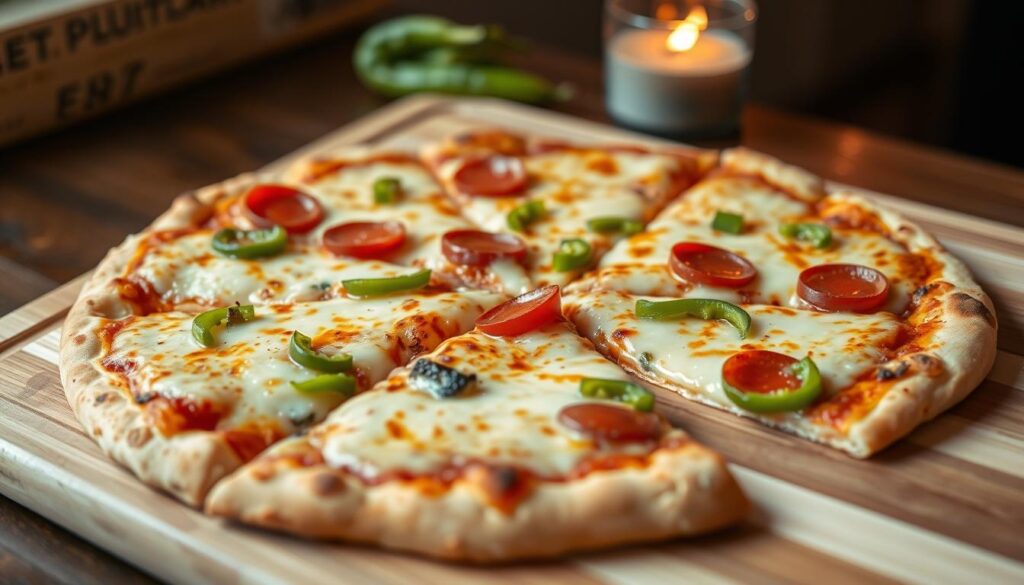
St. Louis-style pizza is a regional favorite with a crust that’s as crunchy as a biscuit. This unique pizza style has gained popularity across the United States, known for its distinct crust and topping combinations.
One of the defining features of St. Louis-style pizza is its crust, which is achieved without using yeast. For more on different pizza styles and recipes, you can explore the flavors.
Secretul aluatului fără drojdie
The crust of a St. Louis-style pizza is made without yeast, resulting in a cracker-like texture. This is achieved by using a specific type of flour and a precise baking technique.
Brânza Provel și alternativele ei
Provel cheese is a signature component of St. Louis-style pizza, known for its low melting point and tangy flavor. It’s applied directly to the crust before adding the sauce and toppings, allowing for clean-cut slices that can be eaten neatly with a knife and fork. If Provel is not available, a mixture of white cheddar, Swiss, and provolone cheeses can be used as an alternative.
Tehnici de preparare a pizzei perfecte acasă
To achieve a pizzeria-quality pizza in the comfort of your own home, several key techniques must be mastered. Making pizza at home can be a fun and rewarding experience, but it requires attention to detail and some essential skills.
Echipamente esențiale pentru pizza de calitate
To make high-quality pizzas, you’ll need a few essential pieces of equipment. These include a pizza stone or baking steel, a pizza peel or sheet pan, and an oven that can reach high temperatures.
Investing in a good pizza stone is crucial. It helps to cook the crust evenly and can achieve a crispy texture that is characteristic of well-made pizzas.

Sfaturi pentru coacerea la temperaturi înalte
Baking your pizza at a high temperature is crucial for achieving a crispy crust and well-cooked toppings. Preheat your oven to its highest temperature setting, and make sure to preheat your pizza stone or baking steel as well.
For an authentic Neapolitan-style pizza, bake at 500°C (932°F) for 10-12 minutes. For other styles, the temperature and baking time may vary.
Greșeli comune și cum să le eviți
Common mistakes when making pizza at home include overloading with toppings, not preheating the oven and stone long enough, and using cold dough. To avoid these issues, use toppings sparingly and ensure your dough is at room temperature before shaping.
| Mistake | Consequence | Solution |
|---|---|---|
| Overloading with toppings | Soggy crust, uneven cooking | Use toppings sparingly |
| Not preheating oven and stone | Undercooked crust | Preheat oven and stone thoroughly |
| Using cold dough | Difficult to shape, poor texture | Let dough come to room temperature |
For more detailed tips on making the perfect pizza at home, check out our guide on how to make perfect pizza at. The timing and techniques may vary based on the style of pizzas you are making.
Concluzie: Explorarea diversității pizzei americane
The diverse world of American pizza is a testament to the country’s melting pot culture and culinary innovation. American pizza styles represent a fascinating culinary map of the nation’s history, immigration patterns, and regional preferences.
Each distinctive style tells the story of its community of origin, from New York’s foldable slices to Chicago’s deep dish, and from Detroit’s caramelized edges to California’s innovative toppings. By understanding these regional variations, we enrich our appreciation of pizza not just as fast food but as a significant cultural artifact that reflects America’s diverse culinary heritage.
To experience the remarkable diversity that has made pizza one of the country’s most beloved dishes, you can explore the various styles at home or visit some of the best pizza places in your city region. The continued innovation in American pizza styles shows no signs of slowing, with new regional variations and fusion approaches constantly emerging in response to changing tastes and ingredients, thus keeping pizza a vibrant part of American culinary life, always ready to be enjoyed in a new order.
FAQ
What is the ideal temperature for cooking dough in a home oven?
The ideal temperature for cooking dough at home is between 450°F to 500°F, similar to a brick oven used in a traditional pizza shop.
How do I achieve a crispy crust when cooking in a pan?
To achieve a crispy crust, preheat your pan in the oven before adding the dough and toppings, and use a moderate amount of oil to prevent the crust from becoming too greasy.
What are some common toppings used in different regional styles of American pizzas?
Different regions have their unique topping preferences; for example, New York-Style pizzas often feature classic combinations like mozzarella, pepperoni, and mushrooms, while California-Style pizzas may include non-traditional toppings like pineapple and barbecue chicken.
Can I use a grill to cook my pizza?
Yes, you can use a grill to cook your pizza. Preheat the grill to a high heat, place the pizza on a preheated stone or pan, and cook for a few minutes on each side until the crust is golden brown and the cheeses are melted.
How do I prevent my pizza from becoming too soggy when adding toppings?
To prevent a soggy pizza, balance your toppings and avoid overloading the pizza with too many wet ingredients. Also, pre-bake the crust for a few minutes before adding the toppings to help it hold its shape.
What is the best way to slice a pizza using a knife?
To slice a pizza cleanly, use a sharp knife or pizza cutter and apply gentle pressure, cutting in a smooth, continuous motion. For a more precise cut, use a pizza wheel or a sharp chef’s knife.
Can I make pizzas with different types of bread or crusts?
Yes, you can experiment with different types of bread or crusts, such as whole wheat, gluten-free, or cauliflower crust, to create unique pizza variations that cater to different tastes and dietary needs.
How long should I cook a pizza with pork toppings?
When cooking a pizza with pork toppings, ensure that the pork is cooked through to a safe internal temperature. Cooking time may vary depending on the type and thickness of the pork topping, so adjust the cooking time accordingly.
